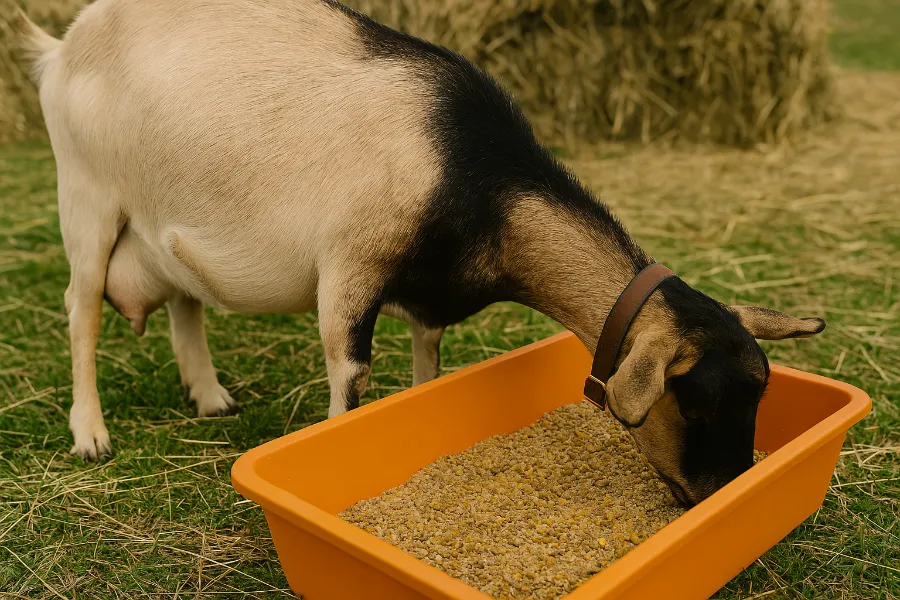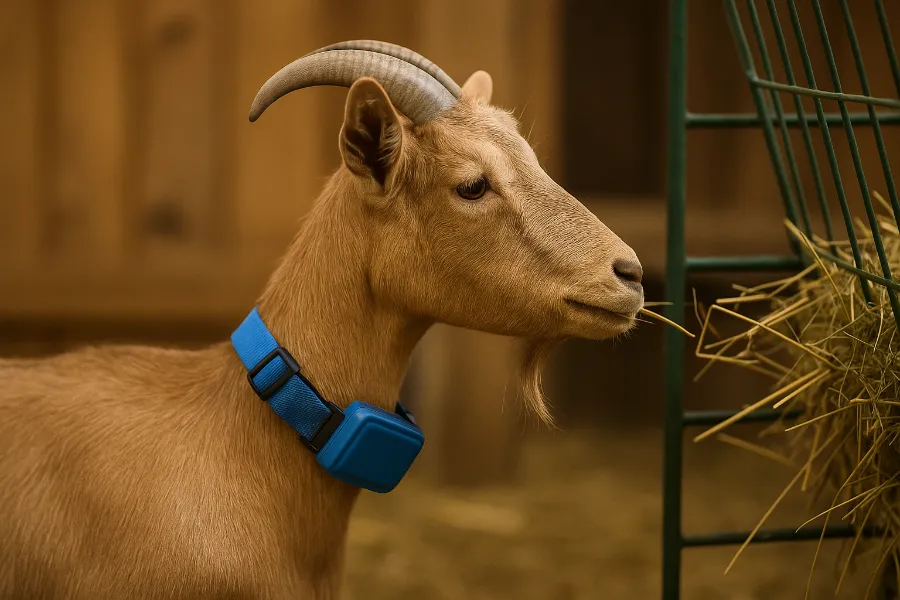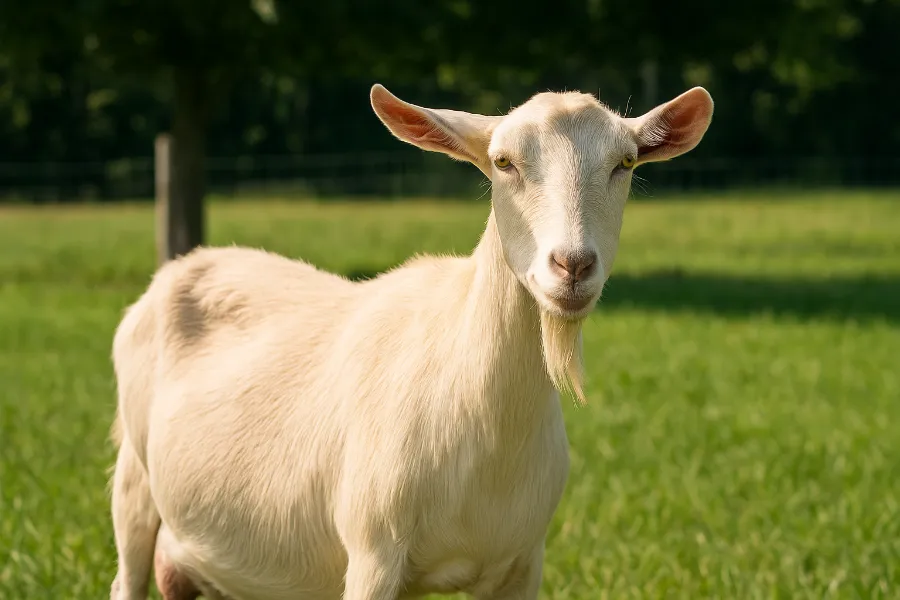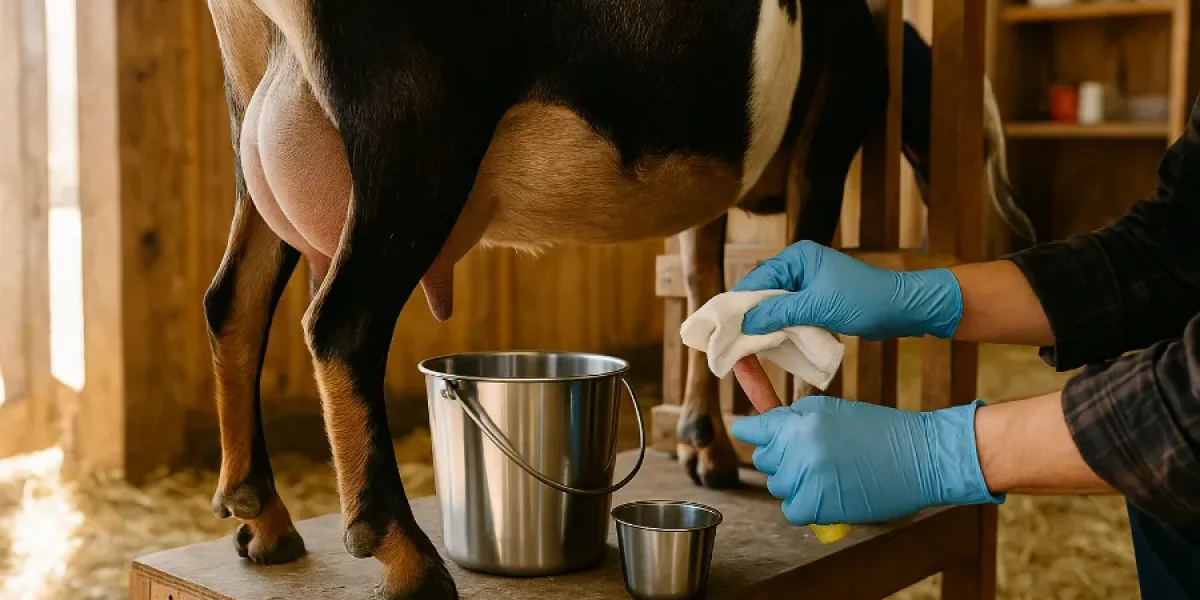If there’s one part of a goat that tells the real story of her health, motherhood, and productivity, it’s the goat udder. Long before the first kid takes its wobbly step or the first stream of milk hits the pail, the udder is quietly preparing for the season ahead.
Whether you’re a homesteader raising dairy goats or a seasoned breeder running a full goat farm, understanding the goat udder is key to good herd management. It’s not just about watching it fill before kidding — it’s about knowing what’s normal, what’s not, and how modern farm technology can make life easier.
Let’s dive into everything the goat udder tells you — from goat pregnancy and colostrum to mastitis prevention, feeding, and even the role of smart farming tools that help monitor it all.
Goat Pregnancy: How the Udder Tells the Story

The first stage of udder change begins long before kidding. During goat pregnancy, hormonal shifts begin preparing the udder for milk production weeks before birth. Around the last month of gestation, mammary tissue starts expanding, milk veins become visible, and the udder — or “bag” as many farmers call it — starts to develop fullness.
Early Udder Development Signs
- Slight swelling at the base of the udder
- Skin becomes more elastic
- Teats start to firm and lengthen
- Veins under the belly become more prominent
This is the body’s way of preparing for colostrum — that golden first milk — and a healthy start for the kids.
By understanding these changes, you can better estimate where your doe is in her pregnancy timeline, which is especially helpful if you didn’t witness the breeding.
Goat Breeding: Building a Foundation for Strong Udders
A strong udder begins with intentional breeding. The genetics behind udder shape, attachment, and production are just as important as milk volume itself.
When choosing breeding pairs, look for does and bucks from lines known for:
- High, snug udder attachments
- Even halves with uniform teats
- Strong medial suspensory ligaments
- Easy milking temperament
These traits not only prevent long-term problems like goat mastitis and sagging udders but also make milking easier and cleaner.
A poorly attached udder can lead to injuries, mastitis risk, and reduced lifespan in high-producing dairy goats.
Goat Colostrum: The Udder’s First Gift
Nothing symbolizes new life quite like goat colostrum.
It’s the thick, yellowish “first milk” that fills the udder in the final 12–24 hours before birth. While some new goat owners think the udder is simply swelling with milk, this phase is actually the colostrum stage, and it’s essential for newborn immunity.
Signs Your Doe Is Producing Colostrum
- Udder becomes tight, shiny, and warm
- Teats fill and may leak small drops
- Doe’s tail ligaments begin to soften
- Appetite decreases slightly
Colostrum contains vital antibodies, fat, and energy that kids must consume within the first few hours of life.
Traditional farmers often hand-strip a few drops to check thickness. Modern smart farming breeders use digital thermometers and apps to track udder temperature, fullness, and timing for precision kidding predictions.
Goat Labor Signs: What the Udder Reveals Before Birth
If you’ve ever paced the barn at night waiting for kids to arrive, you know that the udder gives one of the clearest goat labor signs.
Within 24 hours before kidding, the udder tightens to its fullest point, the teats point slightly outward, and the skin looks stretched and glossy.

Other Key Labor Signs
- Doe becomes restless or isolates herself
- Tail ligaments disappear
- Clear mucus discharge appears
- Frequent pawing or nesting behavior
When the udder feels like it can’t get any tighter, you’re in the final countdown. Traditionally, farmers relied on touch and instinct. Today, a goat collar or goat app can alert you when your doe’s movement and temperature patterns change — meaning labor is near, even while you’re inside the house.
Dairy Goats: Udder Health and Milking Quality
In dairy goats, the udder is everything. The size, symmetry, and texture of the udder directly affect goat milk yield and cleanliness.
An ideal dairy udder is soft, pliable, evenly divided, and high enough to avoid dirt or injury.
After Kidding: Milking and Udder Conditioning
Once the kids have nursed colostrum, milk production ramps up. To maintain udder health:
- Milk regularly to prevent engorgement
- Massage before and after milking to encourage flow
- Disinfect teats to avoid bacterial buildup
- Feed high-quality forage and minerals for milk consistency
This stage determines not just milk production but also the long-term udder health that supports future lactations.
Goat Feed: Nutrition That Builds a Better Udder
A healthy udder is built from the inside out.
Quality goat feed ensures that mammary tissue, milk ducts, and colostrum production function properly throughout pregnancy and lactation.
Essential Feed Components for Udder Health
- Alfalfa or grass hay: Rich in calcium and protein
- Black oil sunflower seeds: Boost healthy fats for creamy milk
- Loose minerals: Especially copper, zinc, and selenium for elasticity
- Fresh water: Crucial for steady milk flow
- Molasses water post-kidding: Restores energy and helps milk letdown
Avoid excessive grain feeding late in pregnancy — it can cause udder edema (swelling without firmness). The goal is a balanced fill, not bloating.
Goat Mastitis: Protecting the Udder from Infection
Every goat keeper eventually faces the challenge of goat mastitis, an inflammation of the udder caused by bacterial infection, poor hygiene, or injury.
It’s painful for the doe and damaging to milk quality.
Common Signs of Mastitis
- One half of the udder becomes hard or hot
- Milk appears clotted, watery, or discolored
- Goat flinches during milking
- Appetite or energy drops
Traditional vs. Modern Management
Traditional: Warm compresses, gentle stripping, herbal salves (like calendula or garlic-infused oils).
Modern: Use of digital thermometers to track temperature spikes, and record data in your goat app to monitor healing progress.
Early detection is everything — a soft, balanced udder after milking means you’re doing it right.
Digital Thermometer: Modern Tool for Udder and Doe Monitoring
A simple digital thermometer is one of the most powerful modern tools for managing your herd.
A slight rise in body temperature can signal early infection, while a small drop often indicates impending labor.
Use it to:
- Track temperature changes during late pregnancy
- Monitor mastitis or infection recovery
- Identify stress or illness before symptoms appear
Pair it with a smart goat collar or app, and you can record all temperature trends automatically — no notebook required.
Smart Farming: Where Tradition Meets Technology

Today’s smart farming blends centuries-old intuition with precision tools.
For goat keepers, this means turning observation into data — and using that data to improve herd health.
Modern farm technology tools for monitoring the goat udder and kidding cycle include:
- Smart collars: Track movement, rest, and temperature
- Infrared cameras: Detect heat patterns for mastitis or kidding signs
- Goat apps: Store breeding, feeding, and milking records
- Automated milk sensors: Measure yield and composition
These innovations don’t replace the hands-on connection we love — they simply make it more accurate, especially for larger farms or remote monitoring.
Goat App: Digital Barn Management at Your Fingertips
Managing a herd used to mean notebooks full of dates, feed notes, and kidding logs.
Now, a goat app does it all — from tracking goat breeding cycles to predicting goat labor signs and logging goat udder changes.
A good goat management app helps you:
- Record udder development photos for comparison
- Schedule health checks and deworming
- Get notifications from goat collars during kidding
- Track milk yield by date or doe
Popular apps even integrate with digital thermometers and smart feeders, giving your farm a real-time dashboard.
Farm Technology: The Future of Udder Monitoring
As small-scale farms evolve, farm technology becomes more accessible.
What used to be reserved for commercial dairies is now affordable for homesteaders who want efficiency and data-driven care.
Imagine this:
A sensor collar detects when your doe’s activity spikes and sends an alert to your phone. You check the camera feed and see she’s pawing the bedding. You walk to the barn and — sure enough — she’s in early labor.
That’s technology working hand-in-hand with your own instincts.
It saves time, prevents missed births, and reduces stress for both you and the herd.
Goat Farm Management: Balancing Tradition and Modern Tools
A well-run goat farm blends observation, care, and smart systems.
Whether you milk two goats for home use or manage thirty for business, the key is consistency.
Traditional Goat Farm Routine
- Morning udder checks for swelling or heat
- Milking on schedule
- Cleaning pails and bedding daily
- Recordkeeping for breeding and milk yield
Modern Enhancements
- Use apps for scheduling
- Install motion or temperature sensors in kidding stalls
- Employ smart collars to track doe health remotely
By blending both worlds, you protect udder health, improve milk output, and reduce the risk of complications like mastitis or low yield.
Dairy Goats and Milk Quality: Reading the Udder
In dairy goats, udder condition directly affects goat milk taste and yield.
A firm, well-formed udder with no lumps ensures clean, rich milk with higher butterfat.
Tips for Quality Goat Milk:
- Milk at consistent times each day
- Filter immediately after milking
- Chill milk quickly to below 40°F (4°C)
- Maintain clean equipment and hands
Healthy udders don’t just make more milk — they make better milk. Every clean, sweet-tasting bottle starts with an udder that’s cared for properly.
The Human Touch: Why Observation Still Matters
Technology has made goat keeping easier than ever, but nothing replaces the bond between keeper and herd.
You can have all the sensors and apps in the world, but you’ll still know your goats best by touch and temperament.
Take a few minutes each evening to feel udders for changes, notice any unevenness, and talk softly to your does. That’s the balance — modern tools for precision, traditional care for connection.
Final Thoughts: The Goat Udder as the Center of Farm Life
The goat udder is more than a milk source — it’s the health barometer of your entire herd.
From goat pregnancy to colostrum, from early labor signs to the final stream of warm milk, every stage tells a story.
With the help of digital thermometers, smart collars, goat apps, and other farm technology, today’s goat farmers can predict, prevent, and perfect more than ever before.
But the heart of good farming still lies in old-fashioned care — the daily touch, the quiet observation, and the respect for the animals that sustain us.
When you learn to read the udder, you’re not just managing goats — you’re mastering the rhythm of life on the farm.
FAQs
A goat’s udder swells as milk and colostrum begin to form in preparation for birth. Hormonal changes increase blood flow and tissue growth, causing noticeable fullness.
A healthy udder feels soft, even, and warm—not hard or hot. The milk should flow smoothly without clots or discoloration.
Most does begin to “bag up” two to six weeks before kidding, though timing varies by breed and parity. First-time does usually fill later than experienced ones.
Keep the udder clean, dry, and milk on a consistent schedule. Use sanitized equipment and monitor for early signs like hardness, heat, or changes in milk.
Yes. Goat collars, farm apps, and digital thermometers track temperature, activity, and labor signs, helping detect udder or health issues early.
Check the udder daily in the last month of pregnancy. Gentle palpation helps you spot changes in size, firmness, or temperature that signal birth readiness.
High-quality hay, balanced minerals, and proper hydration are key. Adding protein sources like alfalfa and sunflower seeds helps build mammary strength and milk quality.













